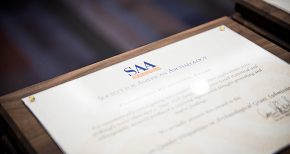Please be aware when registering, all times are in the Eastern Time Zone. Even for free events, you will need to click the "Proceed to Checkout" button and "Submit Order"
to complete your registration. If you do not receive an automated confirmation email, or if you have any questions about registration, please email
onlineseminars@saa.org.
![Underwater Drones? Using Remotely Operated Vehicles in Underwater Archaeology [Foundational Skills]](/images/default-source/default-library/rpa-continuing-professional-education-credits-(2)a97f7c1a76e644129cd4a57c2b7bb842.tmb-seminar.png?Culture=en&sfvrsn=7a99384a_1)
Registration Closed!
Underwater Drones? Using Remotely Operated Vehicles in Underwater Archaeology [Foundational Skills]
When: February 09, 2024 2:00-3:00 PM ET
Duration: 1 hour
Certification: RPA-Certified
Pricing
Individual Registration: Free to SAA members; $69 for non-members
Group Registration: Free to SAA members; $89 for non-members
Dr. Ervan Garrison, PhD, RPA, University of Georgia
Dr. Garrison has taught geology and archaeology at the University of Georgia for over 20 years. From 1990 to 1992 he worked as a Marine Archaeologist at the National Oceanic & Atmospheric Administration (NOAA) and served as research faculty at Texas A&M University from 1979 to 1989. Dr. Garrison received his PhD. from the University of Missouri and both his B.S. and M.A. from the University of Arkansas.
Dr. Garrison has taught geology and archaeology at the University of Georgia for over 20 years. From 1990 to 1992 he worked as a Marine Archaeologist at the National Oceanic & Atmospheric Administration (NOAA) and served as research faculty at Texas A&M University from 1979 to 1989. Dr. Garrison received his PhD. from the University of Missouri and both his B.S. and M.A. from the University of Arkansas.
This seminar provides an introduction to the use of small, low-cost Remotely Operated Vehicles (ROV) in underwater archaeology. A brief history of these vehicles will be presented from early models to today's vehicle designs. Their potential in support of underwater survey and excavations will be outlined and elaborated. Examples of the use of our ROV for these purposes will be presented using video and still-frame images to highlight the discussion. The limitations of ROVs in underwater research will be discussed. Current and future technological and methodological improvements will close the presentation.
1. How ROVs benefit the study of UW archaeological sites.
2. One ROV does not fit all cases. How to choose. ALL ROV sales brochures are wrong.
3. Archiving ROV data as archaeological "big data."
2. One ROV does not fit all cases. How to choose. ALL ROV sales brochures are wrong.
3. Archiving ROV data as archaeological "big data."


